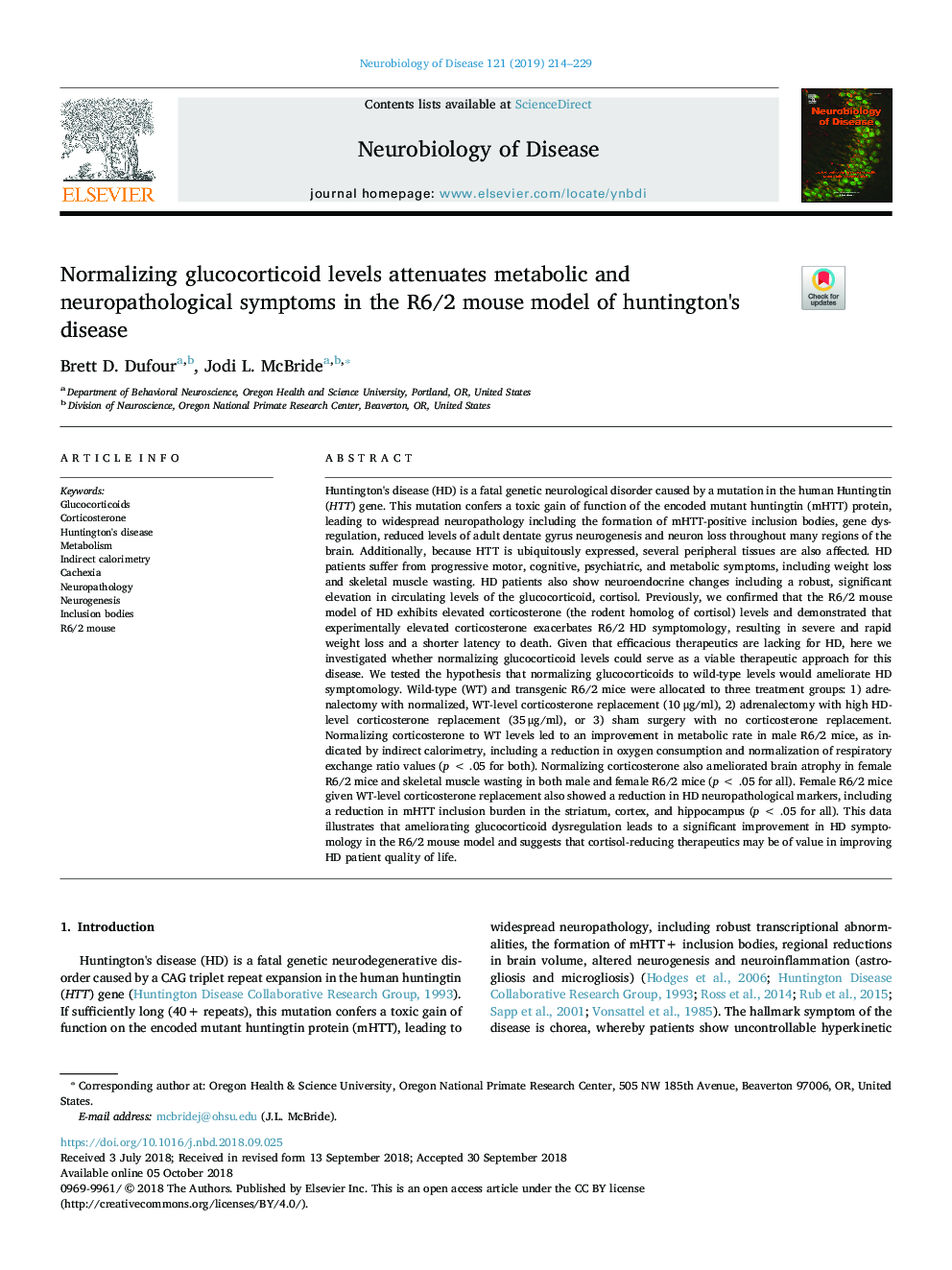| کد مقاله | کد نشریه | سال انتشار | مقاله انگلیسی | نسخه تمام متن |
|---|---|---|---|---|
| 11263533 | 1678819 | 2019 | 16 صفحه PDF | دانلود رایگان |
عنوان انگلیسی مقاله ISI
Normalizing glucocorticoid levels attenuates metabolic and neuropathological symptoms in the R6/2 mouse model of huntington's disease
دانلود مقاله + سفارش ترجمه
دانلود مقاله ISI انگلیسی
رایگان برای ایرانیان
کلمات کلیدی
موضوعات مرتبط
علوم زیستی و بیوفناوری
علم عصب شناسی
عصب شناسی
پیش نمایش صفحه اول مقاله

چکیده انگلیسی
Huntington's disease (HD) is a fatal genetic neurological disorder caused by a mutation in the human Huntingtin (HTT) gene. This mutation confers a toxic gain of function of the encoded mutant huntingtin (mHTT) protein, leading to widespread neuropathology including the formation of mHTT-positive inclusion bodies, gene dysregulation, reduced levels of adult dentate gyrus neurogenesis and neuron loss throughout many regions of the brain. Additionally, because HTT is ubiquitously expressed, several peripheral tissues are also affected. HD patients suffer from progressive motor, cognitive, psychiatric, and metabolic symptoms, including weight loss and skeletal muscle wasting. HD patients also show neuroendocrine changes including a robust, significant elevation in circulating levels of the glucocorticoid, cortisol. Previously, we confirmed that the R6/2 mouse model of HD exhibits elevated corticosterone (the rodent homolog of cortisol) levels and demonstrated that experimentally elevated corticosterone exacerbates R6/2 HD symptomology, resulting in severe and rapid weight loss and a shorter latency to death. Given that efficacious therapeutics are lacking for HD, here we investigated whether normalizing glucocorticoid levels could serve as a viable therapeutic approach for this disease. We tested the hypothesis that normalizing glucocorticoids to wild-type levels would ameliorate HD symptomology. Wild-type (WT) and transgenic R6/2 mice were allocated to three treatment groups: 1) adrenalectomy with normalized, WT-level corticosterone replacement (10â¯Î¼g/ml), 2) adrenalectomy with high HD-level corticosterone replacement (35â¯Î¼g/ml), or 3) sham surgery with no corticosterone replacement. Normalizing corticosterone to WT levels led to an improvement in metabolic rate in male R6/2 mice, as indicated by indirect calorimetry, including a reduction in oxygen consumption and normalization of respiratory exchange ratio values (pâ¯<â¯.05 for both). Normalizing corticosterone also ameliorated brain atrophy in female R6/2 mice and skeletal muscle wasting in both male and female R6/2 mice (pâ¯<â¯.05 for all). Female R6/2 mice given WT-level corticosterone replacement also showed a reduction in HD neuropathological markers, including a reduction in mHTT inclusion burden in the striatum, cortex, and hippocampus (pâ¯<â¯.05 for all). This data illustrates that ameliorating glucocorticoid dysregulation leads to a significant improvement in HD symptomology in the R6/2 mouse model and suggests that cortisol-reducing therapeutics may be of value in improving HD patient quality of life.
ناشر
Database: Elsevier - ScienceDirect (ساینس دایرکت)
Journal: Neurobiology of Disease - Volume 121, January 2019, Pages 214-229
Journal: Neurobiology of Disease - Volume 121, January 2019, Pages 214-229
نویسندگان
Brett D. Dufour, Jodi L. McBride,